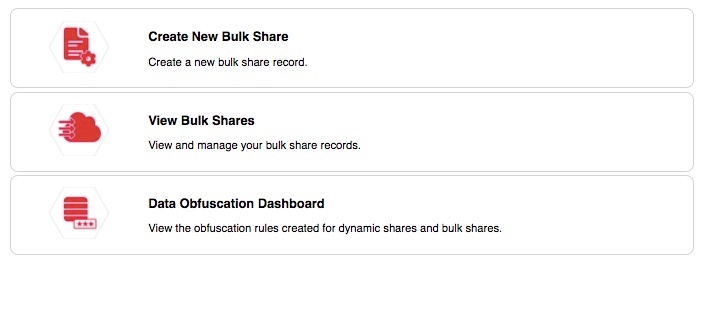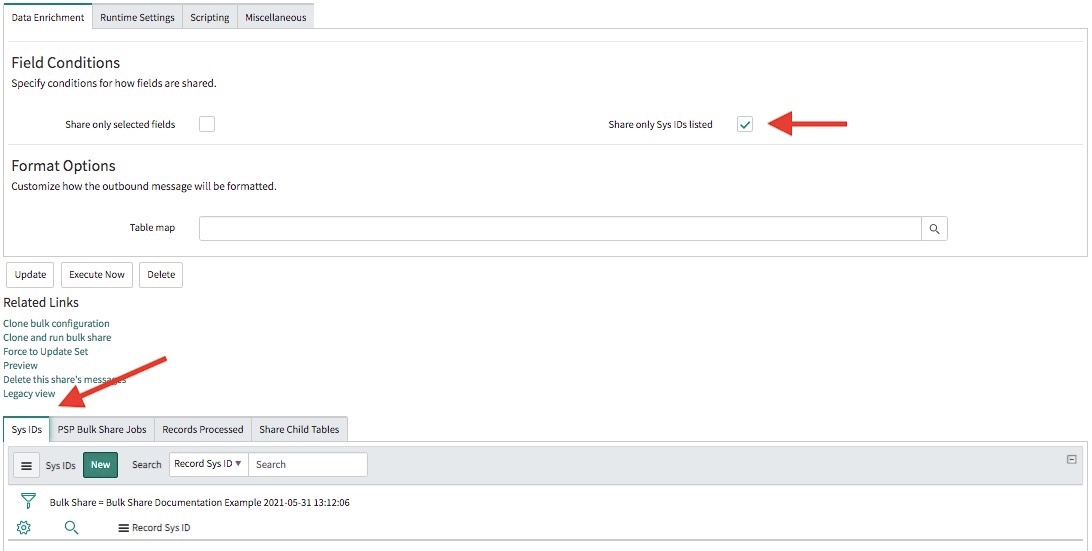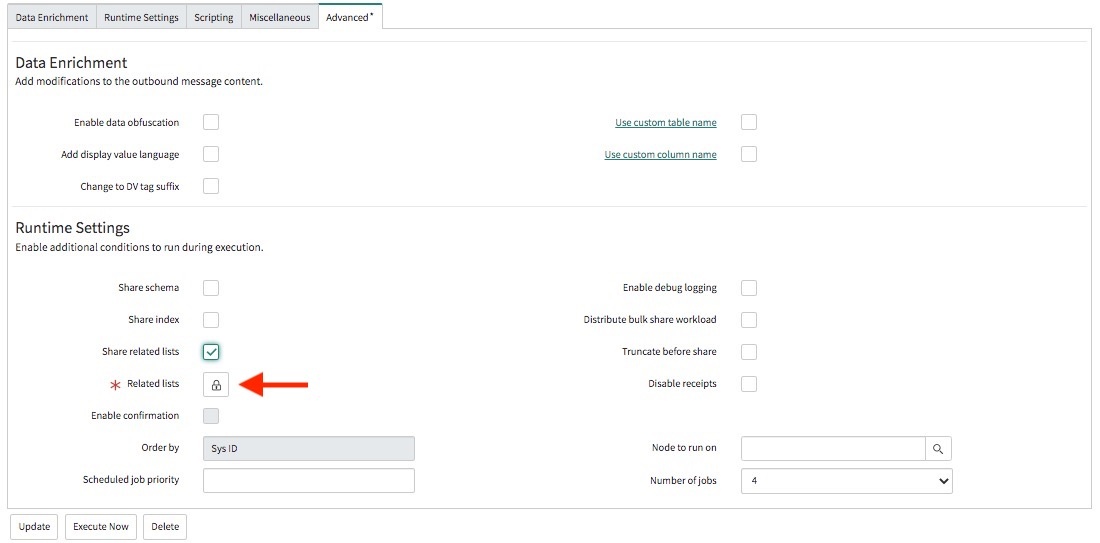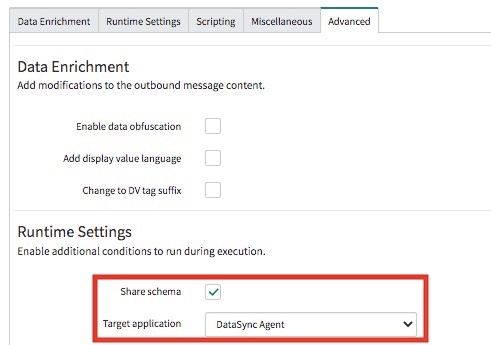Once you have installed and configured DataSync for ServiceNow, and have successfully set up a bulk share and understand how it works, there are various bulk share settings you can configure. These optional features can help you customize your DataSync experience and leverage DataSync's robust capabilities to make your organization's integration processes more powerful and streamlined.
Explore all of these available features below!
Bulk share history set data
This feature allows you to share history set data for the table that you are bulk sharing. History sets in ServiceNow identify which particular records from an audited table contain historical information. History set records only contain a recent subset of historical information (within the past 30 days of inactivity). The following fields will be visible to you in list view for history sets:
Field | Description |
|---|---|
| ID | An identifier for the record whose history is being recorded |
| Table | The audited table for the record whose history is being recorded |
| Load Time | The amount of time it took to generate the history set |
For more information about ServiceNow history sets, see history sets and differences between audit and history sets.
Here's how to enable the sharing of history set data for a bulk share:
- In your sharing ServiceNow instance, go to Perspectium > Perspectium Core > Shares > Bulk Share > View Bulk Shares.
- Find and click into the bulk share (the clickable timestamp) that you want to share the history set data for.
- In the resulting bulk share page, click the Miscellaneous tab, and check the Include history set box.
- Click Update.
With DataSync Agent, this option will create a sys_history_xxx table on the target database.
Clone a bulk share
This feature allows you to simply clone an existing bulk share or clone and immediately run an existing bulk share.
- In your sharing ServiceNow instance, go to Perspectium > Perspectium Core > Shares > Bulk Share > View Bulk Shares.
- Find and click into the bulk share (the clickable timestamp) that you want to clone.
- In the resulting bulk share page, scroll down to the Related Links section, and click Clone bulk configuration to create a duplicate of the current bulk share, or click Clone and run bulk share to create a duplicate of the current bulk share and then immediately execute the newly duplicated share.
Preview a bulk share
This feature allows you to preview a bulk share before executing it. You can see how many records will be shared out and details about when the shared records were created.
Here's how to preview a bulk share:
- In your sharing ServiceNow instance, go to Perspectium > Perspectium Core > Shares > Bulk Share > View Bulk Shares.
- Find and click into the bulk share (the clickable timestamp) that you want to preview.
- In the resulting bulk share page, scroll down to the Related Links section, and click Preview.
- On the resulting preview page, you'll see a the number of records to be shared, and a graph showing when the records were created. Click the menu icon (≡) if you want to download the graph. Click Back to Bulk Share to return to the bulk share record.
Run a bulk share as another user
This feature allows you to run a bulk share as another user, rather than the default system user that has access to all of the table's records. This feature can be useful when you want to limit the bulk share to a subset of data that certain users have access to, such as records in one domain in your domain separated instance.
Here's how to enable this feature:
- In your sharing ServiceNow instance, go to Perspectium > Perspectium Core > Shares > Bulk Share > View Bulk Shares.
- Find and click into the bulk share (the clickable timestamp) that you want to run as another user.
- In the resulting bulk share page, click the Miscellaneous tab, and click the search icon (magnifying glass) next to the Run as field.
- Choose the user to run as for your bulk share.
- Click Update.
Run a bulk share again
This feature allows you to run an existing bulk share again, once it has a status of Completed. You may want to run the same bulk share multiple times if your intent is to migrate the same table data intermittently.
Here's how:
- In your sharing ServiceNow instance, go to Perspectium > Perspectium Core > Shares > Bulk Share > View Bulk Shares.
- Find and click into the bulk share (the clickable timestamp) that you want to run again. It must have a Completed status.
- In the resulting bulk share page, click Execute Again in the top right corner.
Bulk share only sys_id listed
This feature allows you to bulk share out only the sys_ids for specific records. This is useful for when you don't want to create filters for a bulk share.
Here's how:
- In your sharing ServiceNow instance, go to Perspectium > Perspectium Core > Shares > Bulk Share > View Bulk Shares.
- Find and click into the bulk share (the clickable timestamp) for which you want to share only the sys_ids on specific records.
- In the resulting bulk share page, click the Data Enrichment tab, and check the Share only Sys IDs listed box.
- Then, scroll down and click the Sys IDs tab. This tab will only appear once you check the box from Step 3.
- In the Sys IDs tab, click New. If using Google Chrome, you may see a popup asking if you want to leave the site—click Leave.
- On the resulting page, type the sys_id for the first record you want to bulk share out in the Record Sys ID field.
- Click Submit.
- (Optional!) Repeat steps 5-7 for any other record sys_ids you want to bulk share out.
- Once you've added all sys_ids, click Update.
Share database views with bulk share
This feature allows you to properly share database views with a bulk share. By default, bulk shares run by querying for records from the selected table in 1,000 record increments, with records ordered by sys_id in ascending order. This is done to minimize performance impact on the ServiceNow instance. However, the records of database views do not have sys_ids and therefore cannot be shared in the same way. In order to properly share database views with a bulk share, you need to query for all records from the view at once.
To do this, you need to specify the glide.db.max_view_records integer system property to a number above the records in your view. If this property is not set, it defaults to 10,000. A good number to use is 999,999.
Limit the number of records shared
This feature allows you to limit the number of records shared once bulk share reaches a specific limit.
Here's how to turn it on:
- In your sharing ServiceNow instance, go to Perspectium > Perspectium Core > Shares > Bulk Share > View Bulk Shares.
- Find and click into the bulk share (the clickable timestamp) that you want to limit the number of records shared on.
- In the resulting bulk share page, click the Runtime Settings tab, scroll to the Runtime Behavior section, and enter your desired record limit number in the Limit number of records shared field.
- Then, scroll down and click the Sys IDs tab. This tab will only appear once you check the box from Step 3.
- Click Update.
Share updates since then
This feature allows you to share only records that have been inserted or updated since the last time the bulk share ran. This is useful for Scheduled Bulk Shares when you want to ensure you capture all records changed since the last execution of the bulk share.
Here's how to turn it on:
- In your sharing ServiceNow instance, go to Perspectium > Perspectium Core > Shares > Bulk Share > View Bulk Shares.
- Find and click into the bulk share (the clickable timestamp) that you want to configure.
- In the resulting bulk share page, click the Runtime Settings tab, scroll to the Triggers section, and check the Share updates since then box.
- Click Update.
Share as archive
This feature will share archived records as regular table records as part of a bulk share, if and when there is an archived table for a specified table in the bulk share. If you choose to share child records, it will also share the records from the archived child tables.
This feature is to be used with the temporal feature in the DataSync Agent (see step 3).
Here's how to enable share as archive:
- In your sharing ServiceNow instance, go to Perspectium > Perspectium Core > Shares > Bulk Share > View Bulk Shares.
- Find and click into the bulk share (the clickable timestamp) that you want to share archives for.
- In the resulting bulk share page, use the Table name dropdown to select an archived table.
- In the Runtime Settings tab, under the Runtime Behavior section, check the Share as archive box.
- Click Update.
- Sharing additional records (i.e. attachments, journals, etc) are disabled
- "Insert Only" will be disabled if "Share as archive" is enabled
- Since archive tables do not retain table hierarchy (no parents or child tables), it stores one copy of the record to an archive leaf or child-most table. Therefore, “Include all child tables” and “Share base table” won’t behave the same as sharing a regular table.
Distribute bulk share workload
This feature allows you to distribute the work load of your bulk shares by allowing them to run on multiple nodes in your instance. This is useful if you're running multiple bulk shares or scheduled bulk shares, since they will run on the same node by default, and this could impact performance. If you use this feature, nodes will only be used if they are online ad set to accept "any" scheduler.
Here's how to turn it on:
- In your sharing ServiceNow instance, go to Perspectium > Perspectium Core > Shares > Bulk Share > View Bulk Shares.
- Find and click into the bulk share (the clickable timestamp) that you want to configure.
- In the resulting bulk share page, click the Miscellaneous tab, and check the Advanced box. This will reveal an Advanced tab.
- Click the Advanced tab, and check the Distribute bulk share workload box.
- Click Update.
Multiple bulk share jobs
This feature allows you to choose the number of jobs (1, 2, 4, 8, or 16) it will take to process the bulk shared records. Each job will process a subset of the total records, split by sys_id.
Here's how to customize the number of jobs:
- In your sharing ServiceNow instance, go to Perspectium > Perspectium Core > Shares > Bulk Share > View Bulk Shares.
- Find and click into the bulk share (the clickable timestamp) that you want to configure.
- In the resulting bulk share page, click the Miscellaneous tab, and check the Advanced box. This will reveal an Advanced tab (see Distribute bulk share workload for a screenshot).
- Click the Advanced tab, and under the Runtime Settings section, use the Number of Jobs dropdown to select the number of jobs.
- Click Update.
This feature is not compatible with the following bulk share features:
- Order by
- Share only Sys IDs listed
- Limit number of records shared
- Enable confirmation features
Nodes to run on
This feature allows you to specify which node a bulk share will run on by referencing the sys_cluster_state table in ServiceNow. You need admin access (or a custom ACL rule) in order to see and set this value. You may want to run this feature in order to distribute the Perspectium processing across several nodes.
Here's how to specify nodes:
- In your sharing ServiceNow instance, go to Perspectium > Perspectium Core > Shares > Bulk Share > View Bulk Shares.
- Find and click into the bulk share (the clickable timestamp) that you want to configure.
- In the resulting bulk share page, click the Miscellaneous tab, and check the Advanced box. This will reveal an Advanced tab (see Distribute bulk share workload for a screenshot).
- Click the Advanced tab, and under the Runtime Settings section, use the Node to run on field to search for and select a node.
- Click Update.
Order by
This feature allows you to customize the order in which your records in bulk share are sent out by choosing which field (such as Active, Updated, Created On etc.) the records will be ordered by when sending out the records. For example, if you choose the Created On field, the bulk share will send the records in ascending order based on the date and time at which they were created. By default, bulk shares will order records by the Sys ID (sys_id) field when querying for records to share out.
Here's how to send records in a specific order:
- In your sharing ServiceNow instance, go to Perspectium > Perspectium Core > Shares > Bulk Share > View Bulk Shares.
- Find and click into the bulk share (the clickable timestamp) that you want to configure.
- In the resulting bulk share page, click the Miscellaneous tab, and check the Advanced box. This will reveal an Advanced tab (see Distribute bulk share workload for a screenshot).
- Click the Advanced tab, and under the Runtime Settings section, use the Order by dropdown to select the field for the records to be ordered by when shared.
- Click Update.
Share related lists
This feature allows you to share records from one or more related lists of the table being bulk shared. Here's how:
- In your sharing ServiceNow instance, go to Perspectium > Perspectium Core > Shares > Bulk Share > View Bulk Shares.
- Find and click into the bulk share (the clickable timestamp) that you want to configure.
- In the resulting bulk share page, click the Miscellaneous tab, and check the Advanced box. This will reveal an Advanced tab (see Distribute bulk share workload for a screenshot).
- Click the Advanced tab, and under the Runtime Settings section, check the Share related lists box. This will reveal a new Related lists field with a lock icon.
- Click the lock icon next to the Related lists field to unlock the field. This will reveal an empty field and a search bar.
- Use the search bar field to type your desired list, or click the search button to open all related lists of the table and select from there. Alternatively, you can click the Add/Remove multiple icon to add or remove multiple lists at once.
- Click Update.
Table replication in a subscribing instance
This feature allows you to create new tables in a subscribing ServiceNow instance by sharing a schema from one instance to another. This will create the table, field types, choices, labels, values, as well as the following:
- Table sys IDs, columns, and the selection for choice fields
- ACLs
- Other table information, such as extends, auto-number, application process, etc.
Upon receiving the schema message, the table will be created in the instance and a generic subscribe record will be will be created to allow for replication of any records that come with the table schema.
Here's how to use share schema to replicate tables in a subscribing instance:
- In your sharing ServiceNow instance, go to Perspectium > Perspectium Core > Shares > Bulk Share > View Bulk Shares.
- Find and click into the bulk share (the clickable timestamp) that you want to share the schema for.
- In the resulting bulk share page, click the Miscellaneous tab, and check the Advanced box. This will reveal an Advanced tab (see Distribute bulk share workload for a screenshot).
- Click the Advanced tab, and under the Runtime Settings section, check the Share schema box. This will reveal a Target application dropdown.
- Select ServiceNow from the Target application dropdown.
- Click Update.





